0 Volumes
No volumes are associated with this topic
Utopian Refuges
New topic 2017-01-20 00:14:50 description
Wizards of the Wissahickon
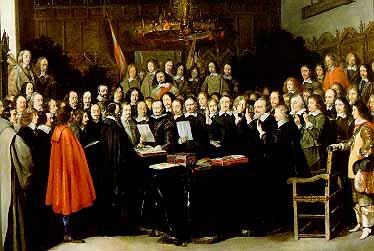
|
| Peace Treaty of Westphalia |
The Holy Roman Empire comprised about 120 little kingdoms along the Rhine River, mostly Germanic, stretching from Amsterdam to Switzerland, and loosely associated with the Papal States extending onward to Sicily. Napoleon and Bismark unified much of this territory into what we might now recognize as a map of Western Europe. Before that, it had been roughly the battleline between Catholic and Protestant populations, provoked by the influence of Martin Luther spreading through what had for centuries been an entirely Catholic region. After the Treaty of Westphalia in 1648, it became a rule of the Holy Roman Empire that the state religion of a country was whatever the local king said it was.
With this history and more, it is unsurprising that the region was filled with small stranded religious sects who were out of local secular favor. William Penn's mother was Dutch, so he could speak the local language and had lived in the region. When this immensely rich Englishman acquired the colony of Pennsylvania, it was natural for him to offer religious sanctuary to Germanic sects as well as to the dissident Quakers of England, in that free-religion colony he planned for his wilderness region, larger than the whole of England.
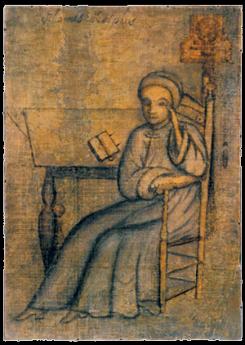
|
| Johannus Kelpius |
From this history it emerges that "Dominie Johann Jacob Zimmerman, a noted German mathematician, astronomer, and defrocked Lutheran minister", led a remarkably well-educated group of "Pietists, millennialists, Rosicrucians, and Separatists" to London and then to Rotterdam, picking up some Swiss, Transylvanians, Swedes and Finns. Among them was a young Transylvanian scholar originally named Kelp, which in scholarly tradition had changed to Johannus Kelpius. Responding to the astronomical calculations of Zimmerman, it was believed the millennium of peace and tranquility predicted by the Book of Revelations would begin more or less immediately. The group resolved to accept the offer of William Penn and go to Pennsylvania to enjoy that millennium. Unfortunately, Zimmerman died as the ship was departing and young Kelpius, who himself was later to die of tuberculosis at the age of 34, was appointed the new leader.
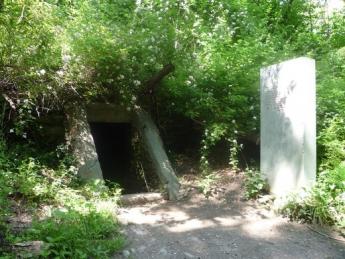
|
| Kelpius Cave |
Evidently, on arrival in Philadelphia in 1694, they encountered earlier inhabitants who had a tradition of a bonfire midway between the solstice and the equinox. Their fire was on top of "Fire Mount", and was taken as a sign that the millennium was now beginning. The group moved up to the top of the Wissahickon, next to where Rittenhousetown is now to be found, and just beyond it in Roxborough was a hollowed out formation resembling an amphitheater. It is now believed an astronomical observatory was created on the projecting rock next to the present foot of the Henry Avenue bridge; it was at that place that two celibate monasteries (for men and for women) lived together, slowly dying out as celibate communities necessarily do. Eventually, the death of Kelpius caused the final break-up of the little colony, but not before it had established itself as a center of music, poetry, and literature for the growing Germanic settlers of the surrounding states. One group of them went further west to the Cloister at Ephrata, and others scattered in different directions. It is notable that a great many names of settlers in the Kelpius colony are still to be found in Germantown, Philadelphia, and Harrisburg, although tracing the genealogy has been difficult. Some of the music has been found in scraps and reconstructed, and discovered to be quite sophisticated and beautiful, although precise authorship remains uncertain.
REFERENCES
| An Introduction to the Music of the Wissahickon Glen: Lucy E. Carroll, DMA, | Kelpius Society |
| The Hymn Writers of Early Pennsylvania: Lucy E. Carroll, ISBN: 978-1606475201 | Amazon |
Molly Maguires of Pennsylvania (2)
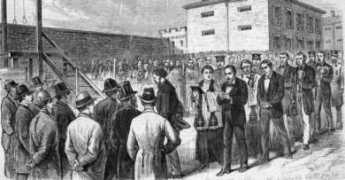
|
| the Mollie threat in the coal regions |
IT was in their interest for both the Molly Maguires and their chief enemies to exaggerate the Mollie threat in the coal regions. Mollies hoped to achieve more pay for less work by intimidating employers, the more intimidation the better. The management of the mines and railroads more shrewdly hoped to mobilize public sympathy to their side, in the newspapers, courts, and legislature, by exaggerating the undoubtedly real menace of lawless, unpatriotic behavior. There have since been great strides in the art of slanted propaganda, and it takes more finesse to mobilize modern opinion. Having watched Hitler and Stalin in action, and noticing our political parties going in the same direction, we would now regard the behavior of 1870 to be crude, and therefore less effective. But there was one very public rebuttal to what the Mollies were claiming. Although they portrayed themselves as oppressed Irish in an English dominated world, their main enemy was himself a well known Irishman.
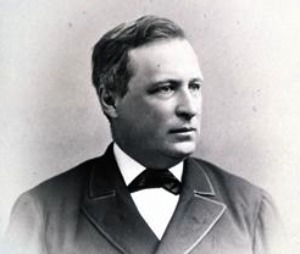
|
| Franklin Benjamin Gowen |
Franklin Benjamin Gowen, President of the Reading Railroad from 1870-1886, was both Irish and definitely larger than life. As one illustration of his extraordinary energy, he died at the age of 53 but had risen from moderate circumstances to control what would become the largest railroad in America by age 34, ultimately being forced from office by J.P. Morgan while still only 50. By some measures, in those sixteen years, he had made the Reading into the largest corporation in the world, even though he had comparatively little interest in and no training in railroading. Although born in Mt. Airy, he apprenticed himself to a lawyer in Pottsville, and at age 26 became District Attorney in the coal region during the first outbursts of Molly Maguire violence. Although he had never gone to law school, he seemed to love the courtroom and continued to work as an independent trial lawyer all during the time he was president of the railroad. One commentator remarked that to read his speeches in cold type was still enough to jeopardize one's judgment. During his later battles for corporate dominance, he twice filled the Academy of Music with stockholders, holding them spellbound for three-hour speeches. On this evidence alone, one. supposes he had a lifelong tendency to stretch facts.
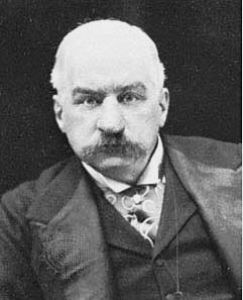
|
| J.P. Morgan |
Following the Civil War, labor relations in this rough coal region became temporarily peaceful. The prosperity of a post-war boom was probably mainly responsible, but it was also true that the labor movement was pretty well smashed by the response to patriotic feelings, slavery was no longer an issue, and huge casualties in the war had created labor shortages. However, these same factors made dominance of the coal and railroad industries more attractive. Franklin Gowen set about merging the small railroads in the coal region into an empire, and used his control of freight costs to force the coal distributors and the coal producers into subservience or forced sales. The charter of the Reading Railroad inconveniently prohibited the railroad from owing mines, but other competitors were legally permitted to do so. Using the fairness argument and probably both bribery and threats, he "persuaded" the legislature to permit a new corporation to own mines, and permitted railroads to own the new corporation. The Reading then promptly owned the mines in a two-step arrangement, couched in bewildering legal language. Gowen had no compunction about doubling freight rates and then doubling them again until he got what he wanted. Anthracite coal was the driving engine of America's Industrial Revolution, and Gowen controlled it. He was a wild and reckless spender, he thought big, and was ready to smash any opposition. His ambition set him to building a transcontinental trunk line which would compete with the Pennsylvania and New York Central lines, both under the control of J. P. Morgan or his allies. This venture failed and became the basis for the present Pennsylvania Turnpike . Ultimately, Gowen's ambitions were thwarted by his reckless spending putting him at the mercy of English bankers, allied to the Morgan interests. Underlying this was an economic fact: Henry Frick had found a way to make bituminous coal into coke, which was a cheaper fuel for steel making than anthracite. Financed by Morgan and organized by Andrew Carnegie, the steel industry moved to Pittsburgh.
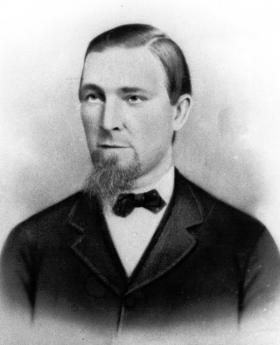
|
| John Sidney, founder WBA |
Meanwhile, what happened to the Molly Maguires? The financial panic of 1873, started by the collapse of Jay Cooke's financial company, precipitated layoffs and cost-cutting and stimulated a new rise of labor unrest. The Mollies shot some mine managers, but most of the labor organized under a fairly moderate union called the Workingmen's Benevolent Association. More moderate or not, they still threatened strikes and demanded concessions, and Gowen set about to wipe them out. As headstrong and impulsive as he was it's even possible he believed the Molly Maguire movement was stronger than it really was. But it would not have mattered. The Pinkerton agency was hired, detailed studies were prepared of the nature and leadership of the Molly movement, evidence of wrong-doing was collected, and some of the right people were hanged. Once more, the labor movement was crushed, largely by characterizing all labor unions as lengthened shadows of the Molly Maguires. And labor has never forgotten or forgiven. Even a century later, any sort of labor ruthlessness especially in Congress, is proclaimed justified since any capitalist, or even any Republican, is a covert Franklin B. Gowen. And quite possibly either English or protestant, as well, even though Gowen happened to be as Irish as any of the Mollies.
It's a great pity that seemingly the last opportunity for national adoption of the Whig philosophy of upward social mobility was exiled from American political discourse. Everybody is better off with peace, law and order; given time, our political system does offer everyone at the bottom of the heap a fair opportunity to rise to the top. After a couple of centuries, it thus ought to be obvious that class warfare hurts everyone, helps no one. But at election time, both parties feel compelled to characterize each other as either a Franklin Gowen, or a Molly Maguire.
As a footnote, Frank Gowen died from a gunshot in Washington DC in 1889. An extensive investigation was conducted, and there is almost complete certainty that no Molly Maguire was responsible. But the bullet came from a strange angle, there was no suicide note, and it remains possible that someone else, not suicide, was responsible. Gowen had plenty of other enemies.
Mennonites: The Pennsylvania Swiss
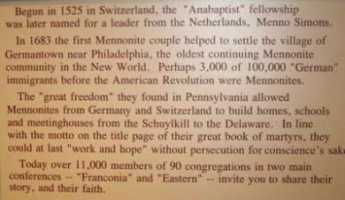
|
| On the Wall of the Mennonite Heritage Center |
Anabaptism, originally attributed to Ulrich Zwingli around 1525, centers around believing a baby is too young to understand baptism, so adults need to be re-baptized. The idea arose independently in Switzerland and Holland, and probably thousands of believers were unmercifully martyred for holding the belief. Because the worst persecutions took place during the War of Austrian Succession (1740-50), they are often attributed to the Roman Catholic Inquisition, but Magisterial Protestants, believing in the separation of church and state, were often also responsible. Many seemingly unrelated issues were introduced locally, and this period of unrest is known as the French and Indian War in America; its major battle took place in Louisburg, Nova Scotia, although George Washington's skirmish around Fort Duquesne (Pittsburgh) has acquired local fame as a major American manifestation.
The Swiss adherents moved to the Rhineland Palatinate, and from there were among the first to accept William Penn's offer of religious freedom. They were the settlers of Germantown, but have mainly moved a few miles west to southern Montgomery County, where the confusion about Pennsylvania Dutchmen is further confounded by the fact that they were Swiss. Menno the Dutchman gave his name to the order, but they themselves regard their true ethnic background as Swiss from the Zurich region. That, by the way, is not to be confused with Calvinism, which also comes from Switzerland, but by way of Geneva, not Zurich. The pacifism of the Mennonites made them mutually attractive with the English Quakers, who had made an appearance fifty or so years later in the region around Manchester, England; each group seems to have adopted some of the features of the other.

|
| Franconia Mennonite Meetinghouse |
Determined use of the German language has always held the Mennonites apart, however. From the start, it was really necessary to be somewhat bilingual in Montgomery County, using English for business conversation, and German at home and in the church. The idea of using a foreign language is based on the hope it would thus maintain a sense of distinctiveness or even remoteness from non-believers, without adopting the least hostility to them. It almost inevitably follows that the group has used its own schools, attached to their meeting houses. This sense of remoteness has persisted for almost four hundred years, surrounded by entirely different cultures. Starting only around 1960, this attitude has gradually softened, however, and it is widely assumed that in another few decades Mennonites will come to resemble the people in their environment a great deal more than they do at present. If you want to know where to find them, Harleysville is a good place to start. As the tinge of Pennsylvania Dutch accent gradually fades, and fewer of them wear the old costumes, a curious remaining hallmark of their presence can be noticed: an avoidance of foundation planting around their houses. The Mennonites themselves seem to be entirely oblivious to this unintended distinctiveness, which is however quite striking to non-Mennonite passers-by. Those who work in the fields all day have little interest in digging around their houses for decoration; those who have moved away from farming have seemingly adopted the bush-less style as a natural way of arranging things. There's no particular reason to change it, and so, there's no particular reason to notice it.
Great Bend: Joseph Smith Translates the Golden Plates
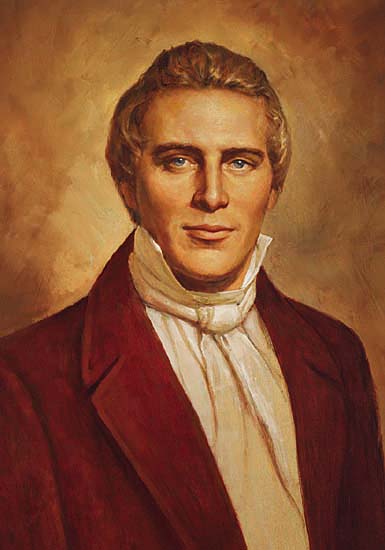
|
| Joseph Smith |
As the traveler up the Pennsylvania Turnpike Northeast Extension approaches the New York border, there's a chance for a fleeting glance at an exit sign pointing to Great Bend, without additional comment. The comment is definitely needed because a ten-mile detour at this point is rewarded by two interesting attractions. In the first place, the Susquehanna does indeed make a great bend there. Starting in Cooperstown, New York at a beautiful mountain lake which resembles Lake Geneva in Switzerland, the Susquehanna heads south for ninety-six miles and then turns around at Great Bend and goes back fifteen miles north to Binghamton. After that, it goes west for forty miles to Sayre and then goes south again as it picks up other branches. Greatly enlarged, it reappears to Turnpike travelers at Wilkes Barre. Thousands of travelers have sped up the wide valley without noticing that the same river which flows south from Wilkes Barre apparently starts flowing north at Great Bend. The traveler's eye is deceived by the apparently continuous long valley which the highway follows. At Binghamton, the Susquehanna starts flowing west, but that too is overlooked in whizzing past the cloverleaves and traffic directions. The Great Bend itself is a lovely water gap with a couple of small towns on its shores, but is otherwise pretty deserted.
For two and a half years, Joseph Smith the founder of the Mormon religion spent full time five miles away from the Turnpike exit, at the real bend in the river (not the town of Great Bend) writing the 275,000 words of the Book of Mormon. Although Smith was a native of Palmyra, New York, and Mormonism is most easily viewed as an outgrowth of wide-spread religious uproar in upper New York State during the 1820s, it undoubtedly provoked malicious gossip from those who resist all claims of miracles, as well as staunch defense from those who believe. It's comparatively safe to say the prophet was living at the Great Bend in his wife's tiny home while she wrote down his dictated translation. The source of his vision was said to be John the Baptist, which others have since taken literally to varying degrees. Those who believe in the pregnancy of virgins and reappearances after a death must be tolerant of the sometimes overstated beliefs of others. Smith never let anyone see the golden plates from which the writings were derived, however, and ultimately it must rest that he was relating what he believed he had seen. His father-in-law described him as a charlatan, an attitude not completely rare among other fathers in law. His wife, caught between conflicting family loyalties, declined for years to join the religion that flowed from her own pen.
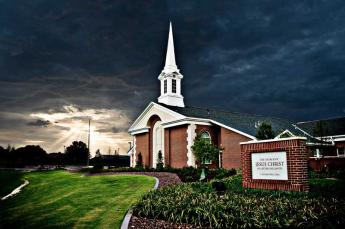
|
| The Church of Jesus Christ of Latter-day Saints |
However, with the publication of the Book of Mormon, Smith rapidly gained adherents numbering in the thousands. He moved the center of the religion westward in several steps and was shot to death by a mob, variously styled as militia and vigilantes, in Illinois at the age of 38. Just who killed him and what the motives were are matters we normally leave to courts rather than newspaper accounts. There is little doubt that many other religions of the time were outraged by the tolerance of polygamy, and so the account that he was assassinated by offended husbands of those to whom he proposed marriage, must be somewhat discounted. All religious disputes have a tendency to get out of hand, and the frontier religions of that time were particularly feverish, flaring up in an environment of the rule of the six-gun.
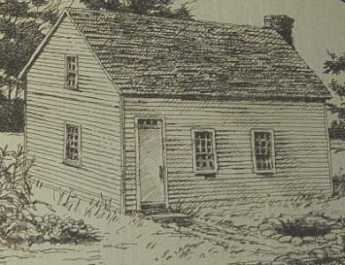
|
| Joseph Smith House |
The attraction of this religion seems to an outsider to have been based on its forgiveness for sinners, offering them tolerant heaven rather than the vindictive hellfire and brimstone which more puritanical protestant sects at that time envisioned for even well-behaved converts. There is a certain echo in Smith's Mormonism of the tolerant Quaker view that "There is that of God, in everyone." Similarly, although it is difficult to accept his idea that the American Indian tribes might be descendants of a lost tribe of Israel from the 7th Century B.C., the Mormon, and Quaker, teaching of tolerance to the Indians was in keeping with changing racial views in the early 19th Century, and softens somewhat the former Mormon distrust of the black race; although that, too, must be seen in the context of the then-approaching Civil War.
The best-known feature of this religion used to be polygamy, however, which is difficult to defend with theological, demographic or even romantic reasonings. With a few exceptions among Mormon extremists, the religion has moved away from any defense of polygamy. As the center of Mormonism moved to Utah, Congress outlawed polygamy, and the church officially condemned the practice and gave it up. Since it is still not rare to encounter a kindly decent gentleman on the streets of Salt Lake City whose grandmother or great-grandmother had been a polygamous wife, the whole subject has come to be treated there as an ancient embarrassment, best left unmentioned, but never quite forgotten. As a matter of fact, all religions have so much to account for in their past that they are most fairly judged by the sort of behavior they seem to inspire in their followers. By that standard, the earnest, decent, hard-working Mormons of today have earned their right not to be sneered at.
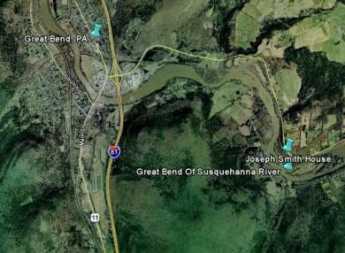
|
| Great Bend PA |
As for the simple little memorial along the river, it may seem a disappointment to some. It has not been made into a tourist attraction or a place of pilgrimage. It may even be a little unprotected from vandalism. But is surely worth the small trouble to visit, adding only half an hour to anyone's trip. One does not have to accept either the history or the theology in order to wish to see the place, which is a sweet little neglected clearing with a railroad running between it and the river. As a backdrop, the great bend in the Susquehanna is a remarkable sight in itself, because the river seems to be running in the wrong direction while no one notices. But one final double-take about polygamy simply cannot be resisted. One of the members of the Right Angle Club spent many years in the Middle East as a diplomat, where every Muslim man is permitted to have four wives. He reports that the younger Muslim men will often have nothing whatever to do with polygamy. Having watched the scheming, conniving jealousies of that custom from a front-row seat, the sort of Arab who always wears western clothes has firmly decided from personal observation that one woman, or at least one woman at a time, is quite enough.
The newspapers tell us a Mormon tabernacle or church may soon be constructed near the new Barnes Museum on the Parkway in Philadelphia. It could even resemble the one in Washington DC, with a statue of the Angel Moroni, blowing a gleaming gold trumpet. The Mormons seem to want Philadelphia to notice them and form an opinion, which indeed we probably will.
4 Blogs
Wizards of the Wissahickon
 The Kelpius Society of Philadelphia is "Dedicated to the study and restoration of the 1694 settlement of the 'Hermits of the Wissahickon' and their goals of community, peace, and brotherhood."
The Kelpius Society of Philadelphia is "Dedicated to the study and restoration of the 1694 settlement of the 'Hermits of the Wissahickon' and their goals of community, peace, and brotherhood."
Molly Maguires of Pennsylvania (2)
 Almost everything the Molly Maguires said about their ruthless enemy the mine owner was accurate. Unfortunately, much of what he said about them was also accurate. And both sides said things that were pure fabrications.
Almost everything the Molly Maguires said about their ruthless enemy the mine owner was accurate. Unfortunately, much of what he said about them was also accurate. And both sides said things that were pure fabrications.
Mennonites: The Pennsylvania Swiss
 Mennonite Pennsylvania Dutchmen actually came here from Switzerland. The book of their religious martyrs is more than a foot thick since they practice non-resistance, a belief significantly more pacifist than non-violence. Nevertheless, they prosper abundantly in Montgomery County.
Mennonite Pennsylvania Dutchmen actually came here from Switzerland. The book of their religious martyrs is more than a foot thick since they practice non-resistance, a belief significantly more pacifist than non-violence. Nevertheless, they prosper abundantly in Montgomery County.
Great Bend: Joseph Smith Translates the Golden Plates
 Joseph Smith announced he discovered the Golden Plates of Mormonism near Palmyra, NY. He spent three years translating them at his wife's home in Great Bend, Pennsylvania.
Joseph Smith announced he discovered the Golden Plates of Mormonism near Palmyra, NY. He spent three years translating them at his wife's home in Great Bend, Pennsylvania.